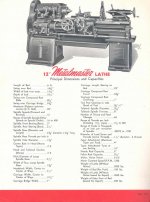My only exposure to Bradford lathes was for one semester of advanced machine shop classes at Brooklyn Technical HS, in about 1966-67. Nothing stands out as noteworthy nor objectionable about the Bradford geared head lathes from that experience. We had a variety of geared head engine lathe in the shops at Brooklyn Tech, so got a chance to run them for however brief a time it was.
The Bradford lathe you picture in your post says a lot. Basically, Bradford was building what I would call a "generic US pattern engine lathe". At that same point in time, the bigger manufacturers like Lodge-and-Shipley, Sidney, Monarch, and the lesser manufacturers like Reed-and-Prentice were all building lathes of the same sort of design and overall appearance. Hendey differed slightly in outer appearance, as did LeBlond.
These were well designed and very well built engine lathes with plenty of iron in them. Internally, there were differences, such as how the headstock gearing was setup for speed changes, whether the gearing was helical or spur (straight cut), whether the gears shifted positions on splined shafts vs use of jaw clutches, whether lubrication was splash, spray, etc.
From what I've seen and run over the past 50 + years, I tend to think these types of engine lathes were built to almost a 'generic' or 'standard' design pattern. They are among the most user-friendly machine tools. They are also extremely rigid with well-designed and massive castings for the beds, headstocks, etc.
I do not know if Bradford flame hardened the beds (as Monarch and some of the other firms did), or whether they used a harder alloy of iron for the beds (as many lathe builders did). Some makers, notably Reed and Prentice, were infamous for their softer beds which wore quickly when compared to their competitors' lathe beds.
If the lathe does not appear to be "beat on", and nothing is broken and all functions work properly, I'd say go for it. Coming out of a motor rebuild shop, this lathe may have seen only lighter usage and was not in a production shop. I'd lift the headstock top cover to check the internal gearing before buying the lathe, if possible.
The lathe is a basic and very solid workhorse. It is one of the least common manufacturer's lathes, but that should not be a detriment in your decision. When we work with old machine tools, we know up front that parts are usually non-existant (unless someone is parting out a similar machine tool), and information may be sketchy.
As I wrote, if the lathe is intact, nothing broken or missing, all functions working properly, I'd jump on it if the price and location were favorable.
This will never be a 'toolroom' lathe, but will turn out some fine work even if you feel a ridge on the bedways and even if there is considerable backlash in the crossfeed and compound. I ran a job on a 1943 Monarch 18" x 72" lathe a couple of years back. That Monarch lathe had been sold to us for scrap price, moved a couple of times, spent 20 + years sitting where it landed in a RR boxcar, and finally wound up in my buddy's shop. I turned a shaft perhaps 36" long with a few different diameters, and was pleased to have about 1/2 thousandth of taper and hit all my diameters dead nuts. Not bad for an old lathe that some would dismiss as too worn, too old, etc. That Monarch has a few very old brazed and welded repairs on some of the levers and brackets, but the main thing is she runs and cuts nice and straight. The Bradford you are interested in will likely be as good a machine tool. I think the generation of lathes that the Bradford lathe was a part of were perhaps the most rugged and best of the US made engine lathes.






